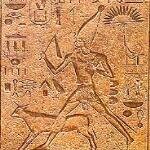|
|
|

Regeneration and political upheaval
| The act of ruling and maintaining ma’at was considered a substantial burden to endure, which over time and old age could diminish. A sacred festival, known as the sed (jubilee) was celebrated, which restored and rejuvenated the pharaoh’s "waning" power. Initially the ceremony was performed during the king’s coronation, then again after a period of some thirty years. It involved the king running (symbolically, as a runner would take the place of the king) around a designated course, holding several objects, including the imyt-per, the title deeds, around two boundary markers that represented The Two Lands. |
 |
 |
| The Sed festival was practiced throughout Pharaonic history. This relief shows Hatshepsut in her role as pharaoh performing the ritual with the sacred Apis bull. |
The earliest known version of the Heb-Sed dates back to King Den c.2950 BCE, carved on an ebony label. This shows the king running around the two boundary markers.
|
The Sed festival allowed Pharaoh to symbolically prove to his people that he was still physically strong enough to carry out his royal responsibilities. always took place on the first day of Peret which was traditionally the first day of the civil calendar, a time of renewal and rebirth.
 |
 |
The ceremony would be performed at more regular intervals after the 30th year if pharaoh thought he needed to regenerate his strength more often, usually due to the effects of old age. Ramesses II, during his 67-year reign celebrated 13 heb-sed festivals, becoming biannual in his latter years. The first attested reference to this sacred ritual is an ebony label, showing King Den c.2950 BCE running the sed course (see above). Indeed, the most famous heb-sed course, can be found at Saqqara, in Djoser’s Southern Court.
|
| Probably the most well known Sed course today is the restored Heb-Sed court at Djoser's Step Pyramid at Saqqara. |
Political upheaval
It is apparent that unification of the country was not widely accepted, and even rebelled against. Power and control of the country was incremental, and only really reconciled at the end of the 1st Dynasty.
This political instability and unrest was reflected in the names of the pharaohs. The first king of the 2nd Dynasty chose the name Hotepsekhemy meaning "The Two Powers are at Peace". Unfortunately, the re-unification was short lived. Only two generations later, the country was split in two, each being ruled separately, with Upper Egypt being ruled from Thinis, whilst the remainder of the country was being ruled from Memphis.
| It has been suggested that evidence of this split can be seen in king Peribsen’s serekh (C.2675 BCE). His serekh has a Seth animal surmounting it, the opposing divinity to Horus (right). His successor Khasekhem (c.2686 BCE) meaning Appearing Powerful seems to have been forced to retreat to Hierkanopolis, from where he was able to mount a victorious counter attack. Regaining power, he amended his name to reflect the re-unification the country. He now called himself Khasekhemwy, meaning The Appearance of the Two Powers. His serekh reflects the reconciliation between the two administrative centres, it is surmounted with the Horus and Seth divinities (far right). |
 |
|
The serekhs of Peribsen and Khasekhemwy reflect the change in political attitudes.
|
The animosity felt between the ruling houses of the two dynasties finally manifests itself, with the deliberate destruction, by fire, of the 1st Dynasty tombs in an effort to erase all traces of their existence.
Khasekhemwy’s re-unification of the country led to a period of internal stability and growth, allowing Egypt to military dominate her neighbours, expanding her borders and gaining wealth through tributes, especially gold from Nubia. It was this strong, stable economic climate that allowed the later Old Kingdom to flourish.
Administration >>
|
|
|











